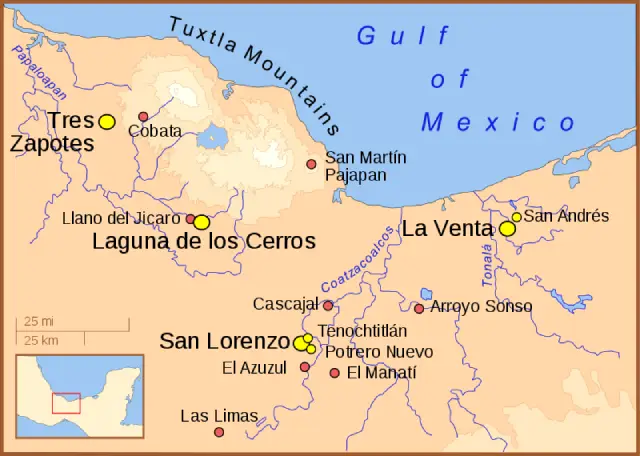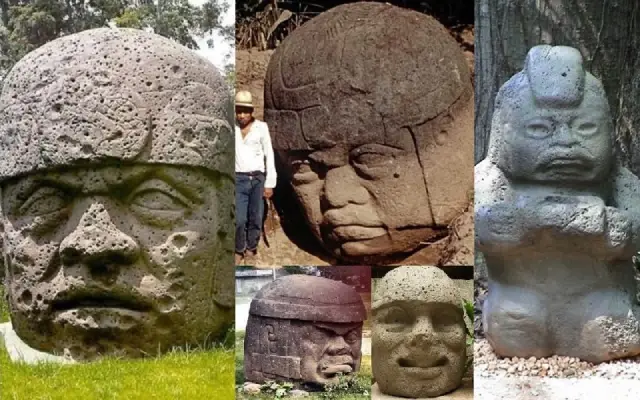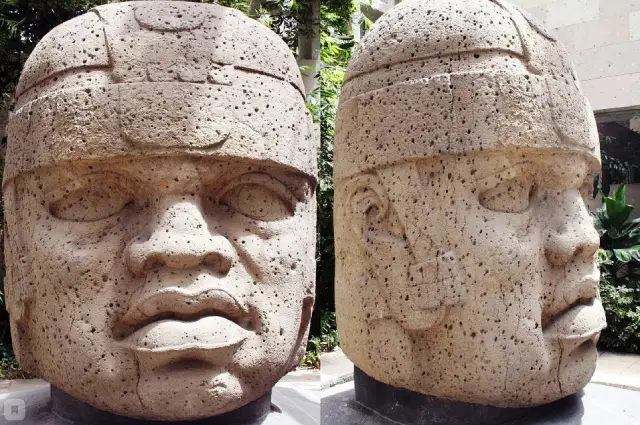Where are the Olmecs from? The first known civilization of America
Where are the Olmecs from? The first known civilization of America
Among the tribes that inhabited Ancient Mesoamerica, the Olmecs appeared not clearly from nowhere in a series of alliances and enmity. However, their name – "people of the country of rubber" was invented in our era. It is known that in the area of the Gulf of Mexico in the time of the Aztecs, that is, shortly before the arrival of the Spaniards in Mexico, there lived a people who called themselves the Olmecs. This name was given to the creators of an unknown Bronze Age culture discovered in Mexico in the first half of the twentieth century. In fact, there is no evidence that the contemporaries of the Aztecs were descendants of those mysterious people who created about three thousand years ago the culture that we today call "Olmec". We don't really know what those ancient people who were awarded the accidental nickname "Olmecs" called themselves. By the way, modern researchers often use the more correct term "people of the La Venta culture".

Diehl, Richard A. (2004) The Olmecs: America's First Civilization, Thames & Hudson, London, p.12.
The Olmec civilization is considered the first, "mother" civilization of Mexico. Like all the other first civilizations, it appears immediately and in a "ready-made form": with a developed hieroglyphic script, an accurate calendar, canonized art, with a developed architecture. According to the ideas of modern researchers, the Olmec civilization arose around the middle of the II millennium BC and lasted for about a thousand years. The main centers of this culture were located in the coastal zone of the Gulf of Mexico on the territory of the modern states of Tobasco and Veracruz. But the cultural influence of the Olmecs can be traced throughout Central Mexico. Until now, nothing is known about the people who created this first Mexican civilization. The name "Olmecs", meaning "people of rubber" is given by modern scientists. But where these people came from, what language they spoke, where they disappeared after centuries — all these main questions remain unanswered after more than half a century of research of the Olmec culture.
What do we know about the Olmec culture?
The Olmecs are the oldest and most mysterious civilization in Mexico. These peoples settled along the entire coast of the Gulf of Mexico, around the third millennium BC. The Coatzacoalcos was the main river of the Olmecs. Its name means "Sanctuary of the Snake". According to legends, it was in this river that the farewell to the ancient deity of Quetzalcoatl took place. Quetzalcoatl, or the Great Kukulan, as the Maya people called him, was a feathered serpent and a mysterious person. This snake had a powerful build, noble facial features, and, in general, quite a human appearance. I wonder where he came from among the red-skinned and beardless Olmecs?
According to the traditions, he came and went by water. It was he who taught the Olmecs all the crafts, the moral foundations, and the counting of time. Quetzalcoatl condemned sacrifice and was against violence... The Olmecs achieved real perfection in the processing of stone, including very hard rocks. Olmec jade products are rightfully considered masterpieces of ancient American art. The monumental sculpture of the Olmecs included multi-ton altars made of granite and basalt, carved steles, sculptures in human growth. But one of the most remarkable and mysterious features of this civilization is the huge stone heads.
Olmec stone heads
The first such head was found back in 1862 in La Venta. To date, 17 such giant human heads have been discovered, ten of them come from San Lorenzo, four from La Venta, the rest are from two more monuments of the Olmec culture. All these heads are carved from solid blocks of basalt. The smallest have a height of 1.5 m, the largest head found on the monument of Rancho la Cobata reaches 3.4 m in height. The average height of most Olmec heads is about 2 m. Accordingly, the weight of these huge sculptures ranges from 10 to 35 tons!

All the heads are made in a single stylistic manner, but it is obvious that each of them is a portrait of a specific person. Each head is crowned with a headdress, most reminiscent of the helmet of an American football player. But all the hats are individual, there is not a single repetition. All heads have carefully designed ears with decorations in the form of large earrings or ear inserts.
Piercing the earlobes was a typical tradition for all the ancient cultures of Mexico. One of the heads, the largest — from Rancho la Cobata, depicts a man with his eyes closed, all the other sixteen heads have their eyes wide open. That is, each such sculpture was supposed to depict a specific person with a characteristic set of individual features. We can say that the Olmec heads are images of specific people. But despite the individuality of the features, all the giant heads of the Olmecs are united by one common and mysterious feature. The portraits of the people depicted in these sculptures have pronounced Negroid features: a wide flattened nose with large nostrils, plump lips, and large eyes. Such features do not fit in with the main anthropological type of the ancient population of Mexico.
Negroid traits
And how to deal with the problem of Negroid traits? Whatever the prevailing theories in historical science claim, there are also facts besides them. An Olmec vessel in the form of a sitting elephant is kept in the anthropological Museum of Xalapa (Veracruz state).

It is considered proven that elephants in America disappeared with the end of the last glaciation, i.e. about 12 thousand years ago. But the Olmecs knew the elephant, so much so that it was even depicted in figured ceramics. Either elephants still lived in the Olmec era, which contradicts the data of paleozoology, or Olmec masters were familiar with African elephants, which contradicts modern historical views. But the fact remains that you can, if not touch it with your hands, then see it with your own eyes in the museum. Unfortunately, academic science diligently bypasses such absurd "trifles". In addition, in the last century, in different regions of Mexico, and on monuments with traces of the influence of the Olmec civilization (Monte Alban, Tlatilco), burials were found, the skeletons in which anthropologists determined to belong to the Negroid race.

In some myths about the creation of the world, which have come down to our days from different Mexican peoples, the appearance of the first cities is associated with newcomers from the north. According to one version, they sailed by boat from the north and landed at the Panuco River, then walked along the coast to Potonchan at the mouth of Jalisco (the oldest Olmec center of La Venta is located in this area). Here the aliens exterminated the local giants and founded the first cultural center of the Tamoanchans mentioned in the legends.
Were there giants?
According to another myth, seven tribes came from the north to the Mexican Highlands. Two peoples already lived here — the Chichimeks and the giants. Moreover, the giants inhabited the lands to the east of modern Mexico City-the districts of Puebla and Cholula. Both peoples led a barbaric way of life, foraging for food by hunting and eating raw meat. The newcomers from the north expelled the Chichemeks, and the giants were exterminated. Thus, according to the mythology of a number of Mexican peoples, the giants were the predecessors of those who created the first civilizations in these territories. But they could not resist the aliens and were destroyed. By the way, a similar situation took place in the Middle East and it is described in sufficient detail in the Old Testament.
There are references to the race of ancient giants that preceded the historical peoples in many Mexican myths. So the Aztecs believed that the earth was inhabited by giants in the era of the First Sun. They called the ancient giants "kiname" or "kinametine". The Spanish chronicler Bernardo de Sahagun identified these ancient giants with the Toltecs and believed that it was they who erected the giant pyramids in Teotihuacan and Cholula. Bernal Diaz, a member of the Cortez expedition, wrote in his book "The Conquest of New Spain" that after the conquistadors gained a foothold in the city of Tlaxcala (east of Mexico City, the Puebla region), local Indians told them that in very ancient times people of huge stature and strength settled in this area. But because they had a bad character and bad customs, the Indians exterminated them. In confirmation of their words, the inhabitants of Tlaxcala showed the Spaniards the bone of an ancient giant. Diaz writes that it was a femur and its length was equal to the height of Diaz himself. the height of these giants was more than three times the height of an ordinary person.

In the book "The Conquest of New Spain", he describes how the Indians told them that in ancient times people of huge stature settled in these places, but the Indians did not agree with them in character and killed everyone.
They also reported that before their arrival, the country was inhabited by giants, rude and wild, who then either died out or were destroyed. As proof, they showed the femur of such a giant. Indeed, she was the size of my full height, and I'm not small. And there were a fair number of such bones; we were surprised and horrified by such a breed of past times and decided to send samples to His Majesty in Spain as well
the quote is taken from the chapter "Friendship with Tlascala".
There was no point in lying to the author, things were discussed much more important than the long-extinct and non-dangerous giants, and it was said and shown by the Indian casually, as a matter of course. And the book is about something else entirely. And if a modern TV channel can still be suspected of falsifying facts in order to raise the rating, then a person who publicly promised 500 years ago to send "non-existent" giant human bones to the king can only be suspected of idiocy.
Which, after reading his book, is very difficult to do. Traces of giants have been found in this area and in the Aztec manuscripts (Aztec codices), who lived later in the same places, in the form of drawings, and in many Mexican myths. A drawing from an Aztec manuscript. Judging by how many people pull one big person, he is also very heavy. Maybe it's his head imprinted in stone?
What do the heads mean?
In addition, it is clear from various sources that the ancient giants inhabited a certain territory, namely the eastern part of central Mexico up to the Gulf coast. It is quite legitimate to assume that the giant heads of the Olmecs symbolized the victory over the race of giants and the victors erected these monuments in the centers of their cities in order to perpetuate the memory of their defeated predecessors.
On the other hand, how can such an assumption be linked to the fact that all the giant Olmec heads have individual facial features? Graham Hancock writes in the book" Traces of the Gods": "The most amazing thing was that Tres Zapotes was not a Mayan city at all. It was completely, exclusively, undoubtedly Olmec. This meant that it was the Olmecs, not the Maya, who invented the calendar, that it was the Olmec culture, not the Maya, that is the "ancestor" of the cultures of Central America… The Olmecs are much older than the Maya. They were a skilled, civilized, technically developed people, and it was they who invented the calendar with dots and dashes, in which the starting point is the mysterious date of August 13, 3114 BC. "
The Olmecs still remain a mystery to archaeologists. It was not possible to find any traces of the evolution of the Olmecs as if these people appeared out of nowhere. Nothing is known about the social organization, rituals, and belief system of the Olmecs, what language they spoke, what ethnic group they belonged to, not a single skeleton of the Olmecs has been preserved. The Maya inherited their calendar from the Olmecs, who used it a thousand years before the Maya. But where did the Olmecs get it from? We never found out...
About author:
Serg Toporkov Ufologist, Ph.D., blogger, I go on my own expeditions for UFOs. I use scientific methods to investigate the UAP phenomenon. Write to me |
Related tags:
Olmecs civilization America Mexico Gulf of Mexico Aztecs Olmec Ancient Mesoamerica La VentaRandom UFO or conspiracy article
The air force General surveillance of the military for intelligent behavior of the UFO
 Many high-ranking military officials claim that UFOs often appear where military maneuvers take place.
Many high-ranking military officials claim that UFOs often appear where military maneuvers take place.
